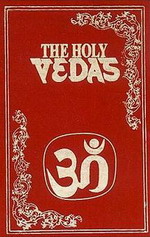The Aryans were a tribal and nomadic people whose origins may have been in the Indo-European homelands of southern Russia. Aryans were fierce warlike people who referred to themselves as noble.1 They used this term to distinguish themselves from those they conquered. Many viewed themselves as superior, and maintained this identity by being fierce. Their warlike nature allowed them to preserve their Vedic religion. Aryans believed in several gods, and they brought their religion to the regions in which they settled, namely to northern India starting around 2000 BCE. Scholars claim that the Vedic religion of the Aryans forms the basis of Hinduism.

The Aryan religion’s beliefs and practices are contained in the four Vedas: the Rig-Veda, the Sama-Veda, the Yajur-Veda, and the Atharva-Veda. The Rig-Veda, “Knowledge of the Hymns of Praise,” is the largest and oldest of the Vedas, and contains hymns to their gods. The Sama-Veda, “Knowledge of the Melodies,” contains hymns for religious rituals used as chants. The Yajur-Veda, “Knowledge of the Sacrificial formulas,” contains instructions for religious rituals and liturgy. Finally, the Artharva-Veda, “Knowledge of the Magic formulas,” was named after a kind of group of priests that cast spells against their enemies and diseases.2 Through the different Vedas, some of their gods were prayed to more than other gods, thus establishing the gods’ significance in the religion.
Although the Aryans worshiped several gods, they did not worship the same gods. Some of the gods that were worshiped in the Aryan religion were Prithivi, Indra, Surya, Vayu, and Agni. Prithivi was the goddess of the earth. Indra was the god of weather and of war. He was called the “breaker of forts” and was what the Aryan men believed a man should be like, namely, a warrior that has courage and energy. Surya was the sun god. Vayu was the god of the wind. Agni was the god of fire. He was the intermediary between the gods and humans. The Aryans believed that the god Agni ate the animals that were burned during their rituals. These sacrifices were carried out by their priests to acquire gifts from the gods, like having children, of obtaining wealth, living long, and being successful in war.3
One of the Aryan religion’s most meaningful rituals was the soma. Soma was a drink that was extracted from the celebrated soma plant described in the Rig- and Sama-Vedas. The ritual has been called the drink of the gods and the elixir of immortality. The drink was extracted from the plant by pressing or crushing the stalk of the plant using a mortar and pestle or pounding the stalks between two stones held in the hands. The extracted drink was then used as an offering to the gods or for drinking. When offered to the gods, they believed a person would gain a healthy long life, happiness, courage, strength, wisdom, and victory over enemies. When used as a drink it was believed to give the drinker understanding and creativity. The drink has also been called the procreator of thoughts as it prevents sleep and keeps the drinker awake and alert.4 The Aryan religion’s beliefs and practices have been the subject of considerable amount of research and debate. Perhaps the most debated aspect is how Hinduism developed from the Aryan religion. The Aryan Vedas are the oldest scriptures of the Hindu religion.
- Jerry Bentley, Herbert Ziegler, and Heather Streets Salter, Traditions & Encounters: A Brief Global History Volume 1, 3 edition (McGraw-Hill Education, 2013), 49. ↵
- Ancient History Encyclopedia, January 2013, s.v. “The Vedas,” by Cristian Violatti. ↵
- Ancient History Encyclopedia, January 2013, s.v. “Aryan,” by Cristian Violatti. ↵
- Encyclopedia Britannica, January 2015, s.v. “Soma.” ↵



29 comments
Nataly Solis Chavez
I’ve never heard of the Vedas nor would I have ever imagined they originated in southern Russia. Their rituals and sacrifices reminded me of the Mayan people who preformed similar ceremonies in order to live long healthy lives, acquire wealth and suitable weather conditions. I especially like how you related their religious beliefs to forming the basis of Hinduism. Overall, the organization and structure of your article flowed very neatly, great job!
Aimee Trevino
Interesting article! I had only ever heard of the Aryians in war, so I find it fitting that Indra, their god of war was what they believed a man should be like. Basically, they were raised to be courageous, have a lot of energy, and be ready for war. I also find it interesting that they had their “drink of the gods” gave them either energy or creative insight; would be extremely helpful.
Faisal Alqarni
Before readig your article I had only here of the word Aryan race in description of people who believed that cauccassiona people were superior to others. Now to learn the beginnings of this Aryan race and their religion that seems very Asian than Western makes really opens my eyes to the possibilities of the world of the old times. I like your detailed explaining of the function of each of the Vedas and rituals performed by this great people.
Cameron Adelman
Interesting article, though I (and I’m sure many other people) would have liked to hear what connection what this religion had (if any) to Nazi Germany and the so-called Aryan master race. Even if there is no real connection, I think the term is stigmatized enough that it probably should have warranted at least a mention. Other then that, I definitely enjoyed reading your article. Great work.
Nicolas McKay
This was an outstanding article. I knew very little about the Aryans prior to reading this and basically knew them by name only. Soma was perhaps the most interesting part of this article, although I think a modern word for such a magic elixir would be coffee. All jokes aside it was very interesting learning about their culture and religious practices.
Christian Lozano
It is unfortunate many people think of the Aryan Brotherhood or Hitler’s “Master Race” when they hear of the word Aryan. But in reality, as this article explains, the Aryans were a nomadic people who conquered many other peoples and had a religion which still survives in some ways today, especially through Hinduism.
Andres Palacios
I’ve read before the Vedas and I knew they had a huge influence in the beginnings of Hinduism, but I did not know they came from southern Russia and that they worshipped so many gods, one for each element. Very well written and explanatory article, great job!.
Mehmet Samuk
Very interesting. I am not really surprised that they were from Russia and warlike people. I think the hard weather and lifestyle made the people in Central Asia and above very fierce. Though, I never thought that Aryans formed the basis of Hinduism. They had gods for almost every element and I was surprised to read that one of them was eating their burned animals at rituals.
Analina Devora
I did an article that mentioned the vedas so most of this information if familiar. However, I didn’t know the origins of these people began in Russia. I also didn’t know that they worshipped and gave sacrifice to different gods. This article has great detail and is well researched and organized. Well done!